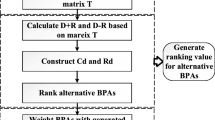Abstract
Dempster’s combination rule can only be applied to independent bodies of evidence. One occurrence of dependence between two bodies of evidence is when they result from a common source. This paper proposes an improved method for combining dependent bodies of evidence which takes the significance of the common information sources into consideration. The method is based on the significance weighting operation and the “decombination” operation. A numerical example is illustrated to show the use and effectiveness of the proposed method.




Similar content being viewed by others
Explore related subjects
Discover the latest articles, news and stories from top researchers in related subjects.References
Cattaneo ME (2011) Belief functions combination without the assumption of independence of the information sources. Int J Approx Reason 52(3):299–315
Deng Y, Shi W, Zhu Z, Liu Q (2004) Combining belief functions based on distance of evidence. Decis Support Syst 38(3):489–493
Denœux T (2008) Conjunctive and disjunctive combination of belief functions induced by nondistinct bodies of evidence. Artif Intell 172(2):234–264
Deng Y (2015) Generalized evidence theory. Appl Intell 43(3):530–543
Destercke S, Dubois D (2011) Idempotent conjunctive combination of belief functions: Extending the minimum rule of possibility theory. Inf Sci 181(18):3925–3945
Guralnik V, Mylaraswamy D, Voges H (2006) On handling dependent evidence and multiple faults in knowledge fusion for engine health management. In: Aerospace Conference. IEEE, pp 9–17
Huynh V, Nakamori Y, Ho T, Murai T (2006) Multiple-attribute decision making under uncertainty: the evidential reasoning approach revisited. IEEE Transactions on Systems, Man and Cybernetics. Part A: Syst Hum 36(4):804–822
Liu L, Yager RR (2008) Classic works of the dempster-shafer theory of belief functions: An introduction. In: Classic works of the Dempster-Shafer theory of belief functions. Springer, pp 1–34
Monney PA, Chan M (2007) Modelling dependence in dempster-shafer theory. Int J Uncertain Fuzziness Knowl-Based Syst 15(1):93–114
Shafer G (1976) A mathematical theory of evidence, Volume 1. In: A Mathematical Theory of Evidence, Volume 1. Princeton university press, Princeton
Smets P (1992) The concept of distinct evidence. In: Proceedings of the 4th Conf on Information Processing and anagement of Uncertainty in Knowledge-based Systems (IPMU). Palma de Mayorca, pp 789–794
Smets P (1995) The canonical decomposition of a weighted belief. In: IJCAI, vol 95, pp 1896–1901
Smets P (2002) The application of the matrix calculus to belief functions. Int J Approx Reason 31(1):1–30
Smets P, Kennes R (1994) The transferable belief model. Artif Intell 66(2):191–234
Su X, Mahadevan S, Xu P, Deng Y (2015a) Dependence assessment in Human Reliability Analysis using evidence theory and AHP. Risk Anal 35:1296–1316
Su X, Mahadevan S, Xu P, Deng Y (2015b) Handling of dependence in dempstershafer theory. Int J Intell Syst 30:441–467
Wu Y, Yang J, Liu L et al (1996) On the evidence inference theory. Inf Sci 89(3):245–260
Xiao W, Wang Z, Wang Y (2011) Combination rule for dependent evidences. Control Decis 26(5):773–776
Xu P, Su X, Mahadevan S, Deng Y (2014) A non-parametric method to determine basic probability assignment for classification problems. Appl Intell 41(3):681–693
Yager RR (2009) On the fusion of non-independent belief structures. Int J Gen Syst 38(5):505–531
Acknowledgments
This work was partially supported by National Natural Science Foundation of China, Grant No. 61503237, Grant No. 61174022, Grant No. 51107080, Chongqing Natural Science Foundation (for Distinguished Young Scholars), Grant No. CSCT, 2010BA2003, General Motors R & D at Vanderbilt University (Project No. ND0044200), and Joint PhD Student Scholarship of SJTU, Shanghai Key Laboratory of Power Station Automation Technology (No.13DZ2273800).
Author information
Authors and Affiliations
Corresponding author
Rights and permissions
About this article
Cite this article
Su, X., Mahadevan, S., Han, W. et al. Combining dependent bodies of evidence. Appl Intell 44, 634–644 (2016). https://doi.org/10.1007/s10489-015-0723-5
Published:
Issue Date:
DOI: https://doi.org/10.1007/s10489-015-0723-5




